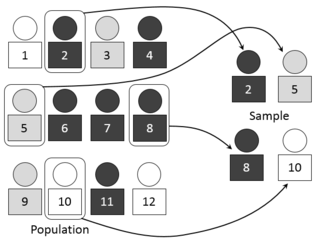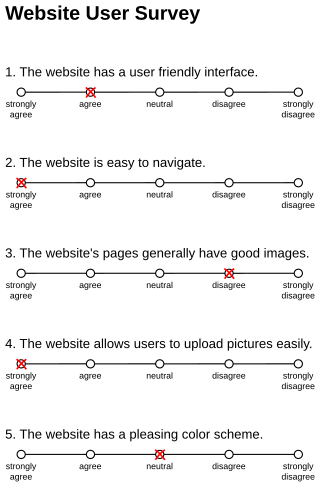Related Research Articles
In statistics, sampling bias is a bias in which a sample is collected in such a way that some members of the intended population have a lower or higher sampling probability than others. It results in a biased sample of a population in which all individuals, or instances, were not equally likely to have been selected. If this is not accounted for, results can be erroneously attributed to the phenomenon under study rather than to the method of sampling.
Cultural bias is the interpretation and judgment of phenomena by the standards of one's own culture. It is sometimes considered a problem central to social and human sciences, such as economics, psychology, anthropology, and sociology. Some practitioners of these fields have attempted to develop methods and theories to compensate for or eliminate cultural bias.

In statistics, quality assurance, and survey methodology, sampling is the selection of a subset or a statistical sample of individuals from within a statistical population to estimate characteristics of the whole population. The subset is meant to reflect the whole population and statisticians attempt to collect samples that are representative of the population. Sampling has lower costs and faster data collection compared to recording data from the entire population, and thus, it can provide insights in cases where it is infeasible to measure an entire population.
Statistical bias, in the mathematical field of statistics, is a systematic tendency in which the methods used to gather data and generate statistics present an inaccurate, skewed or biased depiction of reality. Statistical bias exists in numerous stages of the data collection and analysis process, including: the source of the data, the methods used to collect the data, the estimator chosen, and the methods used to analyze the data. Data analysts can take various measures at each stage of the process to reduce the impact of statistical bias in their work. Understanding the source of statistical bias can help to assess whether the observed results are close to actuality. Issues of statistical bias has been argued to be closely linked to issues of statistical validity.
An opinion poll, often simply referred to as a survey or a poll, is a human research survey of public opinion from a particular sample. Opinion polls are usually designed to represent the opinions of a population by conducting a series of questions and then extrapolating generalities in ratio or within confidence intervals. A person who conducts polls is referred to as a pollster.
Selection bias is the bias introduced by the selection of individuals, groups, or data for analysis in such a way that proper randomization is not achieved, thereby failing to ensure that the sample obtained is representative of the population intended to be analyzed. It is sometimes referred to as the selection effect. The phrase "selection bias" most often refers to the distortion of a statistical analysis, resulting from the method of collecting samples. If the selection bias is not taken into account, then some conclusions of the study may be false.
Egocentric bias is the tendency to rely too heavily on one's own perspective and/or have a higher opinion of oneself than reality. It appears to be the result of the psychological need to satisfy one's ego and to be advantageous for memory consolidation. Research has shown that experiences, ideas, and beliefs are more easily recalled when they match one's own, causing an egocentric outlook. Michael Ross and Fiore Sicoly first identified this cognitive bias in their 1979 paper, "Egocentric biases in availability and attribution". Egocentric bias is referred to by most psychologists as a general umbrella term under which other related phenomena fall.

Response bias is a general term for a wide range of tendencies for participants to respond inaccurately or falsely to questions. These biases are prevalent in research involving participant self-report, such as structured interviews or surveys. Response biases can have a large impact on the validity of questionnaires or surveys.
Internal validity is the extent to which a piece of evidence supports a claim about cause and effect, within the context of a particular study. It is one of the most important properties of scientific studies and is an important concept in reasoning about evidence more generally. Internal validity is determined by how well a study can rule out alternative explanations for its findings. It contrasts with external validity, the extent to which results can justify conclusions about other contexts. Both internal and external validity can be described using qualitative or quantitative forms of causal notation.

A scientific control is an experiment or observation designed to minimize the effects of variables other than the independent variable. This increases the reliability of the results, often through a comparison between control measurements and the other measurements. Scientific controls are a part of the scientific method.
External validity is the validity of applying the conclusions of a scientific study outside the context of that study. In other words, it is the extent to which the results of a study can generalize or transport to other situations, people, stimuli, and times. Generalizability refers to the applicability of a predefined sample to a broader population while transportability refers to the applicability of one sample to another target population. In contrast, internal validity is the validity of conclusions drawn within the context of a particular study.
The "ceiling effect" is one type of scale attenuation effect; the other scale attenuation effect is the "floor effect". The ceiling effect is observed when an independent variable no longer has an effect on a dependent variable, or the level above which variance in an independent variable is no longer measurable. The specific application varies slightly in differentiating between two areas of use for this term: pharmacological or statistical. An example of use in the first area, a ceiling effect in treatment, is pain relief by some kinds of analgesic drugs, which have no further effect on pain above a particular dosage level. An example of use in the second area, a ceiling effect in data-gathering, is a survey that groups all respondents into income categories, not distinguishing incomes of respondents above the highest level measured in the survey instrument. The maximum income level able to be reported creates a "ceiling" that results in measurement inaccuracy, as the dependent variable range is not inclusive of the true values above that point. The ceiling effect can occur any time a measure involves a set range in which a normal distribution predicts multiple scores at or above the maximum value for the dependent variable.
An open-access poll is a type of opinion poll in which a nonprobability sample of participants self-select into participation. The term includes call-in, mail-in, and some online polls.
A self-report study is a type of survey, questionnaire, or poll in which respondents read the question and select a response by themselves without any outside interference. A self-report is any method which involves asking a participant about their feelings, attitudes, beliefs and so on. Examples of self-reports are questionnaires and interviews; self-reports are often used as a way of gaining participants' responses in observational studies and experiments.

In fields such as epidemiology, social sciences, psychology and statistics, an observational study draws inferences from a sample to a population where the independent variable is not under the control of the researcher because of ethical concerns or logistical constraints. One common observational study is about the possible effect of a treatment on subjects, where the assignment of subjects into a treated group versus a control group is outside the control of the investigator. This is in contrast with experiments, such as randomized controlled trials, where each subject is randomly assigned to a treated group or a control group. Observational studies, for lacking an assignment mechanism, naturally present difficulties for inferential analysis.
In natural and social science research, a protocol is most commonly a predefined procedural method in the design and implementation of an experiment. Protocols are written whenever it is desirable to standardize a laboratory method to ensure successful replication of results by others in the same laboratory or by other laboratories. Additionally, and by extension, protocols have the advantage of facilitating the assessment of experimental results through peer review. In addition to detailed procedures, equipment, and instruments, protocols will also contain study objectives, reasoning for experimental design, reasoning for chosen sample sizes, safety precautions, and how results were calculated and reported, including statistical analysis and any rules for predefining and documenting excluded data to avoid bias.
Impact evaluation assesses the changes that can be attributed to a particular intervention, such as a project, program or policy, both the intended ones, as well as ideally the unintended ones. In contrast to outcome monitoring, which examines whether targets have been achieved, impact evaluation is structured to answer the question: how would outcomes such as participants' well-being have changed if the intervention had not been undertaken? This involves counterfactual analysis, that is, "a comparison between what actually happened and what would have happened in the absence of the intervention." Impact evaluations seek to answer cause-and-effect questions. In other words, they look for the changes in outcome that are directly attributable to a program.
Participation bias or non-response bias is a phenomenon in which the results of elections, studies, polls, etc. become non-representative because the participants disproportionately possess certain traits which affect the outcome. These traits mean the sample is systematically different from the target population, potentially resulting in biased estimates.
In social psychology, illusory superiority is a cognitive bias wherein people overestimate their own qualities and abilities compared to others. Illusory superiority is one of many positive illusions, relating to the self, that are evident in the study of intelligence, the effective performance of tasks and tests, and the possession of desirable personal characteristics and personality traits. Overestimation of abilities compared to an objective measure is known as the overconfidence effect.
Heuristics is the process by which humans use mental shortcuts to arrive at decisions. Heuristics are simple strategies that humans, animals, organizations, and even machines use to quickly form judgments, make decisions, and find solutions to complex problems. Often this involves focusing on the most relevant aspects of a problem or situation to formulate a solution. While heuristic processes are used to find the answers and solutions that are most likely to work or be correct, they are not always right or the most accurate. Judgments and decisions based on heuristics are simply good enough to satisfy a pressing need in situations of uncertainty, where information is incomplete. In that sense they can differ from answers given by logic and probability.
References
- ↑ Ziliak, S.T., McCloskey, D.N. (2008) The Cult of Statistical Significance: How the Standard Error Costs Us Jobs, Justice, and Lives, University of Michigan Press. ISBN 0-472-05007-9
- ↑ Lenskyj, Helen Jefferson (2008). Olympic Industry Resistance: Challenging Olympic Power and Propaganda . State University of New York Press. p. 56. ISBN 978-0-7914-7479-2.
- Jacobs, B., Hartog, J., Vijverberg, W. (2009) "Self-selection bias in estimated wage premiums for earnings risk", Empirical Economics, 37 (2), 271–286. doi : 10.1007/s00181-008-0231-0